Looking for thoughts on these types of things? With a sealed cab behind the active driver and PR in front, vs PR units either side of an internal active. Merits of the active being in clamshell isobaric on the internal baffle thing? .....purpose is to maximise power density and minimise cab volume by means of isobaric and PR approaches with a helping hand to the SPL as well
The PR of a bandpass acts like a vent.
One closed chamber and one vented (or with PR) is a 4th order bandpass.
PR on both sides would be a 6th order BP. Depending on where the second PR radiates:
Generally a 6th order has more efficiency and/or bandwidth than a 4th order BP.
I suggest you install hornresp and start experimenting with it!
(If you haven't done already)
One closed chamber and one vented (or with PR) is a 4th order bandpass.
PR on both sides would be a 6th order BP. Depending on where the second PR radiates:
- into first enclosure: serial 6th order BP
- to the exterior: parallel 6th order BP
Generally a 6th order has more efficiency and/or bandwidth than a 4th order BP.
I suggest you install hornresp and start experimenting with it!
(If you haven't done already)
Bandpass is usually not small, but allows deeper rolloff/higher output.very high output/very small cabs
If a small cab is your first priority, you may be better off with a vented/PR or closed (and equalized) box.
Have a look at my 6th order serial BP test box:
https://www.diyaudio.com/community/...rbers-and-port-geometries.388264/post-7434308
I had the misconception that a driver would have a higher output in a bandpass over a BR
And a tentative thought to bring the bandpass box size down closer to the BR size by eliminating a lot of port volume by using a PR and internal volume by going isobaric while increasing power
A 40-150hz passband with that 12" 17mm xmax 450wrms driver. Two of them in isobaric off a 500wrms x 2 amp
And a tentative thought to bring the bandpass box size down closer to the BR size by eliminating a lot of port volume by using a PR and internal volume by going isobaric while increasing power
A 40-150hz passband with that 12" 17mm xmax 450wrms driver. Two of them in isobaric off a 500wrms x 2 amp
It (usually) does, but restricted to a more narrow bandwidth.a driver would have a higher output in a bandpass over a BR
don't do that. bass output is mostly displacement limited, which does not increase with isobaric configuration. if you need to reduce size why not use a smaller driver?going isobaric
Edit: you really need to start simulating. It allows you to check power, output, displacement ... try hornresp!
I have taken up a lot of time doing sims and then finding that I still don't have the contextual knowledge to interpret the results properly, with you folks finding issues that I didn't even know existed in the graphs with things like pipe resonances and such
Your remarks about the isobaric system is surprising. My uneducated understanding is that 'two' larger drivers in isobaric will need a volume similar to 'one' smaller driver while offering the Fs of a 'single' larger driver, which in most cases is better than that of a smaller driver. And then on top, the clamshell enables a cleaner displacement of a 'single' larger driver. So if that 12" in isobaric end up similar volume to a 10 while going lower and dissipating more power as audio through cleaner xmax which is longer than the 10s and has more Sd than how does the bass not increase?.......man you have confused the hell out of me as I consider you the educated types
Your remarks about the isobaric system is surprising. My uneducated understanding is that 'two' larger drivers in isobaric will need a volume similar to 'one' smaller driver while offering the Fs of a 'single' larger driver, which in most cases is better than that of a smaller driver. And then on top, the clamshell enables a cleaner displacement of a 'single' larger driver. So if that 12" in isobaric end up similar volume to a 10 while going lower and dissipating more power as audio through cleaner xmax which is longer than the 10s and has more Sd than how does the bass not increase?.......man you have confused the hell out of me as I consider you the educated types
I built a bandpass subwoofer with PR a couple of years ago. The target BW is 20 Hz to 120 Hz. I found several issues with the finished subwoofer:
There is noticable output outside of the passband, at mid frequencies. Perhaps this can be cured by an active filter. It is very disturbing without filtering.
The biggest issue is the huge group delay. It s so disturbing that the subwoofer is unlistenable. Actually I never put it into service because of the crap sound.
This is anouther good experience where the promising design meets the disappointing listening experience.
There is noticable output outside of the passband, at mid frequencies. Perhaps this can be cured by an active filter. It is very disturbing without filtering.
The biggest issue is the huge group delay. It s so disturbing that the subwoofer is unlistenable. Actually I never put it into service because of the crap sound.
This is anouther good experience where the promising design meets the disappointing listening experience.
With drivers with huge Vas, a 50% size reduction was a "big" deal.
The clamshell pair occupies at least double the cabinet volume of a single, increasing net volume, so overall cabinet size reduction will be considerably less than 50% with the small Vas of most "modern" drivers.
The isobaric pair can put out the same acoustic power as a single driver in a larger box, but dissipates (converts to heat) twice the electrical power doing it.
Double the driver and amplifier power cost (and weight..) for a minor reduction in cabinet volume..
The clamshell pair occupies at least double the cabinet volume of a single, increasing net volume, so overall cabinet size reduction will be considerably less than 50% with the small Vas of most "modern" drivers.
The isobaric pair can put out the same acoustic power as a single driver in a larger box, but dissipates (converts to heat) twice the electrical power doing it.
Double the driver and amplifier power cost (and weight..) for a minor reduction in cabinet volume..
Noted, will be interesting to see this effect and compare with the same driver in a BRI built a bandpass subwoofer with PR a couple of years ago. The target BW is 20 Hz to 120 Hz. I found several issues with the finished subwoofer:
There is noticable output outside of the passband, at mid frequencies. Perhaps this can be cured by an active filter. It is very disturbing without filtering.
The biggest issue is the huge group delay. It s so disturbing that the subwoofer is unlistenable. Actually I never put it into service because of the crap sound.
This is anouther good experience where the promising design meets the disappointing listening experience.
The isobaric pair can put out the same acoustic power as a single driver in a larger box, but dissipates (converts to heat) twice the electrical power doing it
Noted
Just a quick comparison to show the basic difference in that the BP6 yields a narrow BW gain down low at the expense of a significant loss higher up.
To get the BP6 to outperform a specific driver's power response in the same size BR box is to use differing driver specs that yields a nominally flat response in the desired BW.
Of course the quickie/unrealistic Altec 416-8B driver spec changes done in HR would need to be 'juggled' to find drivers with a 'close enough' flat alignment, so strictly for educational purposes and no, did all these 'on the fly', so no text files to Export.
and no, did all these 'on the fly', so no text files to Export. 
To get the BP6 to outperform a specific driver's power response in the same size BR box is to use differing driver specs that yields a nominally flat response in the desired BW.
Of course the quickie/unrealistic Altec 416-8B driver spec changes done in HR would need to be 'juggled' to find drivers with a 'close enough' flat alignment, so strictly for educational purposes

Attachments
-
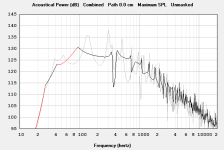 Comparing a BP6 to BR.PNG5.9 KB · Views: 28
Comparing a BP6 to BR.PNG5.9 KB · Views: 28 -
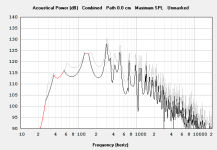 Comparing a BP6 to same BP6 with optimized driver specs.PNG6 KB · Views: 21
Comparing a BP6 to same BP6 with optimized driver specs.PNG6 KB · Views: 21 -
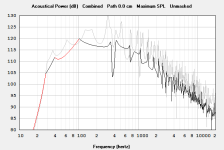 Comparing a BP6 with optimised specs to BR.PNG6 KB · Views: 24
Comparing a BP6 with optimised specs to BR.PNG6 KB · Views: 24 -
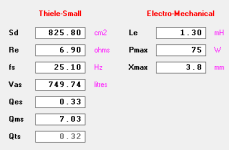 BP6 OEM driver specs.PNG1.5 KB · Views: 26
BP6 OEM driver specs.PNG1.5 KB · Views: 26 -
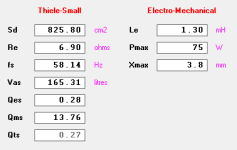 BP6 optimized driver specs.PNG1.6 KB · Views: 24
BP6 optimized driver specs.PNG1.6 KB · Views: 24 -
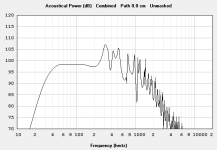 BP6 optimized driver specs response plot.PNG4 KB · Views: 26
BP6 optimized driver specs response plot.PNG4 KB · Views: 26
I find my Overdrive10 to be a marvelous little monster for what it does. The design of the PR bandpass is key to keep the sensitivity from dipping, the bandwidth wide enough, and the group delay as low as possible. It is a juggling act I did in Unibox for the simulation.
Make the active driver mount through the PR hole, and be 1 size larger or capable of 2x xmax swept volume of the active driver. In my case it was a 10" active and 12" passive.
The lowend generally is limited in these kinds of designs if you want the bass to extend into the 70Hz+ range, while keeping the mass on the PR low, group delay low, and decent sensitivity. This generally means boost at the bottom end is the normal requirement, and more robust high xmax drivers are typical. Sealed boxes are not easy to get lower extension from, so this makes sense. Smaller Vas, mid Q, and higher Mms drivers help keep the boxes smaller.
No pipe resonances, steep combined upper rolloff, and tight air volumes help make my design diminutive and snappy. It sounds great....
Make the active driver mount through the PR hole, and be 1 size larger or capable of 2x xmax swept volume of the active driver. In my case it was a 10" active and 12" passive.
The lowend generally is limited in these kinds of designs if you want the bass to extend into the 70Hz+ range, while keeping the mass on the PR low, group delay low, and decent sensitivity. This generally means boost at the bottom end is the normal requirement, and more robust high xmax drivers are typical. Sealed boxes are not easy to get lower extension from, so this makes sense. Smaller Vas, mid Q, and higher Mms drivers help keep the boxes smaller.
No pipe resonances, steep combined upper rolloff, and tight air volumes help make my design diminutive and snappy. It sounds great....
Can we also look from the perspective of price vs performance aspect? With the price of decent PR units whether as a pair of same Sd or a single larger unit being around similar or more than the active driver, can better performance be achieved with the use of two active drivers instead?
You really need to define "better performance" to make a price vs performance comparison.Can we also look from the perspective of price vs performance aspect? With the price of decent PR units whether as a pair of same Sd or a single larger unit being around similar or more than the active driver, can better performance be achieved with the use of two active drivers instead?
A single SLAPS-M12 has an Sd of 483sq.cm. and Xmax/Xlim of 50mm (100mm peak to peak).
You simply can not find a single or pair of active drivers with equal displacement for near it's price (~$80-$100).
Each doubling of excursion for an active driver requires +6dB more power, so price vs performance of the PR is also a clear winner regarding amp cost.
That said, the PR displacement only "counts" around Fb, so no question a pair of active drivers can have more output about 1/3 octave and above Fb.
Higher performing would be any lift in any area without a loss in another
By a second active driver, I mean one on the front and one on the back of the cab and wired so that they move together in the same direction as when in clamshell. But instead coupled by the cab volume
By a second active driver, I mean one on the front and one on the back of the cab and wired so that they move together in the same direction as when in clamshell. But instead coupled by the cab volume
- Home
- Loudspeakers
- Subwoofers
- PR'ed bandpass?